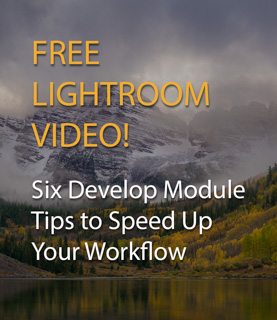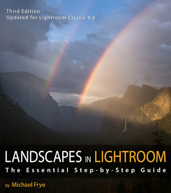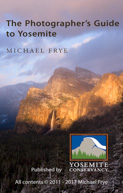Night Photography
by Michael Frye | Dec 2, 2014 | Night Photography
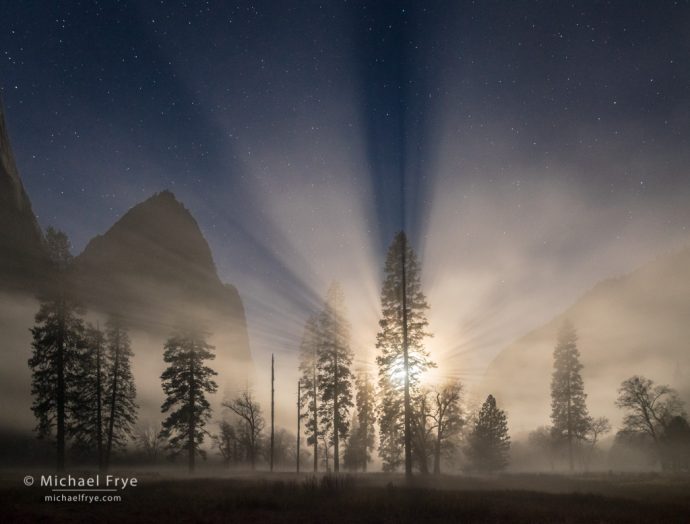
Moon setting on a misty night, El Capitan Meadow, Yosemite
Sunday night at around 11 o’clock I was, naturally, thinking about going to bed. But I decided to check the satellite images online to see if it might be worth getting up early. The skies had been overcast in the afternoon, with some light showers. Now the satellite images showed skies clearing.
It occurred to me to check the moon. I knew the moon was waxing (getting closer to full every day), but wasn’t sure exactly what stage it was in. Looking at PhotoPills told me the moon was at 71% (about three-quarters full), and due to set at 1:42 a.m. The angle of the moonset – 273 degrees – was interesting, as it was similar to the angle of the setting sun in late March, which is a good time of year for late-afternoon photographs from Tunnel View.
Hmm… A quick look outside revealed some interesting, low-hanging clouds. If I moved quickly I could reach the valley before the moon went down. And if there were clouds, and some mist from the rain, I could perhaps make a nighttime version of this late-March photograph, using the setting moon, instead of the setting sun, to illuminate Cathedral Rocks and Bridalveil Fall. There wouldn’t be much water in the fall, but still, it might be interesting, and worth a try.
(more…)
by Michael Frye | Nov 25, 2014 | Night Photography
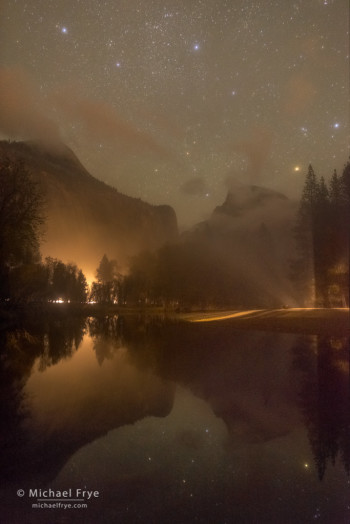
Half Dome, North Dome, and the Merced River at night, with illumination by car headlights, Yosemite
It rained here on Friday night and Saturday morning. The storm cleared Saturday afternoon, so once again I drove up to Yosemite Valley. Unfortunately clouds closed in and muted the light at sunset, but I decided to wait. I remembered a dusk photograph I made from Tunnel View a couple of years ago (the top image in this post), and thought the same light might occur again.
Well lightning didn’t strike twice, and the dusk light wasn’t that interesting. But again I decided to wait. I knew there wouldn’t be any moonlight, but interesting mist was floating around the valley, and I thought starlight might be enough to illuminate some scenes, with perhaps some additional help from car headlights.
(more…)
by Michael Frye | Oct 5, 2014 | Night Photography
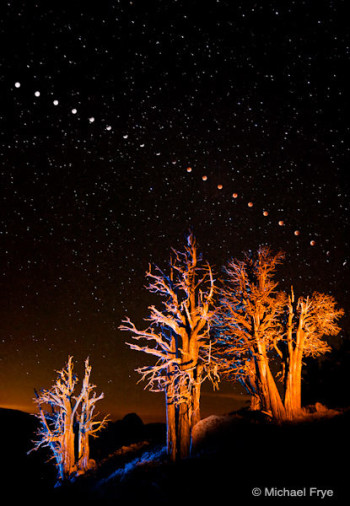
Lunar Eclipse Sequence, 1:23 a.m. to 4:49 a.m., August 28, 2007, Yosemite National Park, California
Lunar eclipses are spectacular events to see and photograph. I’ve been lucky enough to capture several lunar eclipse sequences over the years, including this one from Yosemite in August 2007.
We’re all going to get another chance at photographing an eclipse soon: a total lunar eclipse will be visible throughout North America early Wednesday morning, October 8th.
In the western half of the U.S. the entire eclipse sequence will be visible, from full moon, to partial eclipse, to total eclipse, and back to full again. In California the moon will be high in the sky to the west-southwest at the beginning of the sequence, then sink near the horizon to the west by the end of the sequence. The moon’s path will actually be somewhat of similar to path in this photograph, except that the eclipse will be higher in the sky and a bit further to the right, and the angle of the moon’s path will be steeper.
On the east coast the moon will set when its fully eclipsed, so it won’t be visible as its coming out of the eclipse. But that means the moon will be near the horizon when its fully eclipsed, where you might be able to photograph it next to an interesting foreground object as the dawn lightens the sky. It should be just north of due west as it sets.
For precise guidance about the moon’s position in relation to the landscape, I recommend consulting PhotoPills or The Photographer’s Ephemeris. Here’s the timing for the eclipse:
(more…)
by Michael Frye | Sep 22, 2014 | Night Photography
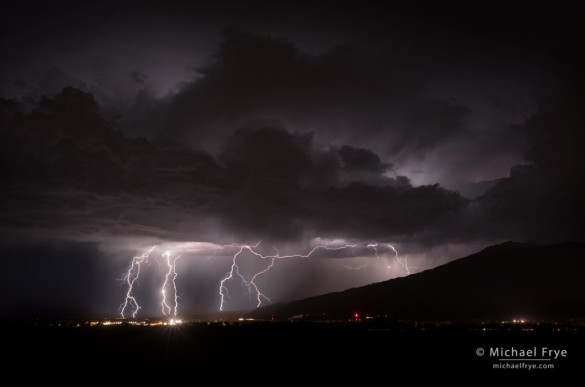
Lightning over Bishop and the Owens Valley, CA, USA
Over the weekend Claudia and I made our annual pilgrimage to the Millpond Music Festival in Bishop, over on the eastern side of the Sierra. This is the 15th consecutive year we’ve attended this festival. Hanging out with friends, listening to music underneath the high peaks of the Sierra, made for a wonderful, relaxing, fun weekend. And as a bonus, I got to photograph some interesting weather.
The land around Bishop is semi-desert, so it doesn’t get much rain. We’ve been sprinkled on a couple of times at Millpond, but had never experienced any serious rain – until Saturday.
A weak low-pressure system pulled some remnants of Hurricane Odile up from the south. Clouds and thunderstorms developed over the mountains, but missed Bishop and the Owens Valley until Saturday evening. As the second-to-last act of the day was performing, a few raindrops fell. I looked at radar images on my phone, and saw some serious-looking storm cells moving right up the valley from the south. I estimated that we had an hour or two before we got dumped on. Figuring that the last performance would be cancelled anyway, I decided to try and get some lightning photographs.
(more…)
by Michael Frye | Sep 9, 2014 | Night Photography
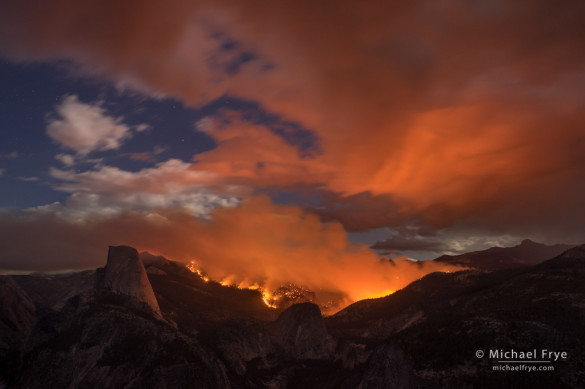
Meadow Fire burning in Little Yosemite Valley at night, with Half Dome on the left, Yosemite; 9-7-14, 8:44 p.m.
Sunday afternoon Claudia and I saw dramatic images on the Yosemite webcams of a fire in Little Yosemite Valley. We’ve had many fires around here the last two summers, and I’ve made plenty of fire photographs. But how often can you photograph a fire next to Half Dome? We decided to head up to Washburn Point (near Glacier Point) to take a look.
The origin of this fire is officially under investigation. The park service has been letting the lightning-caused Meadow Fire burn for awhile, and it’s likely that embers from the Meadow Fire were picked up and blown into an area with heavy fuels, then were fanned by the wind. But it’s also possible that this is a new fire with an unknown cause.
In either case, the winds caused this fire to blow up suddenly Sunday at about 12:30 p.m., closing all the trails in and around Little Yosemite Valley, and forcing the park service to evacuate 50 hikers from the top of Half Dome by helicopter! A big news story, as you can imagine. As of yesterday, the fire was estimated at 2,600 acres. They’re using helicopters, air tankers, and ground crews to contain it. All the park roads and facilities are open, and fortunately no one has been injured by the fire.
There were quite a few photographers at Washburn Point Sunday night, and no wonder – the fire was a spectacular sight. Moonlit clouds kept streaming in from the south, and several times we saw lightning in the distance. Two separate rain showers just missed us, but passed directly over the fire. The first shower seemed to noticeably dim the flames. After the second, heavier shower, a large bank of fog rose up, obscuring the fire and Half Dome. The fog may actually have been steam, created by water hitting the fire. These brief showers didn’t put the fire out, but they probably slowed it down.
(more…)
by Michael Frye | Sep 7, 2014 | Night Photography
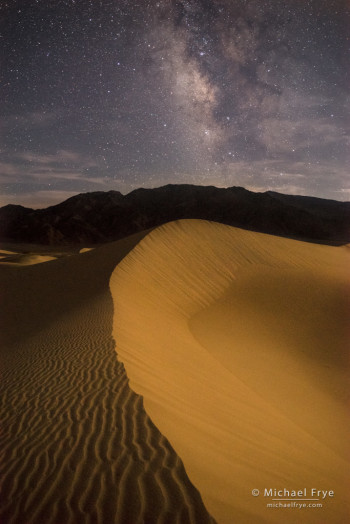
Moonlit sand dunes and the Milky Way, Death Valley. This is the photograph I originally envisioned from Death Valley, with dunes lit by the setting moon and the Milky Way above. (20 sec. at f/2.8, 6400 ISO)
Where do you go to escape the crowds on Labor Day weekend? How about Death Valley, where the temperature was forecast to be 112 degrees! That should keep the tourists away.
Okay, escaping the crowds wasn’t really the motivation for going to Death Valley in August. I had an idea for making a photograph with low-angle moonlight illuminating the sand dunes, and the Milky Way above. The moon had to be in the right phase: too much moonlight and the sky would become washed out, obscuring the Milky Way and most of the stars; too little and you wouldn’t see the effect of the moonlight on the dunes.
The moon also had to be far enough from the Milky Way to keep the moon itself out of the photograph, as it would be impossible to properly expose both the moon and the landscape in the same frame. The moon also needed to be close to the horizon, and off to the side (with the camera pointed at the Milky Way), as that low-angle sidelight would emphasize the form and texture of the dunes.
Not long ago I wrote about two apps for forecasting the position of the Milky Way and moon, PhotoPills and Star Walk. Consulting both of these apps I had figured out that the moon and Milky Way would be in the right position for the photograph I had in mind on the Friday and Saturday before Labor Day. And the next time the moon and Milky Way would be in a good position for this would be… next April, or even May. I decided to brave the heat rather than wait.
I had initially planned to go to Death Valley on Friday, but a thick bank of high clouds moved in – the remnants of Tropical Storm Marie. Since the skies looked clearer further south, Claudia and I kept driving and headed for the Trona Pinnacles.
(more…)







